| Builder(s): | Hinterhoeller Yachts Ltd. |
|---|
| Hull Length: | 20 feet ( 6.1 meters ) |
|---|---|
| Waterline Length: | 17.5 feet ( 5.3 meters ) |
| Beam: | 7 feet ( 2.1 meters ) |
| Draft: | 0.67 feet ( 0.2 meters ) |
| Displacement: | 600 lbs ( 272.2 kg ) |
| Sail Area: | 178 ft ( 16.5 m ) |
| Hull Type: | Centerboard (Trunk) |
|---|---|
| Construct Material: | Fiberglass |
| Rig Type: | Fractional Sloop |
| Sail Area: | 178 ft ( 16.5 m ) |
| Displacement To LWL: | 50 |
|---|---|
| Hull Speed: | 5.6 Knots ( 6.4 miles/hour, 10.4 km/hour ) |
| LWL To Beam: | 2.5 |
| Motion Comfort: | 3.8 |
| Capsize Ratio: | 3.3 |
| Pounds per Inch Immersion: | 438 |


Review of Cygnus 20
Basic specs..
The hull is made of fibreglass. Generally, a hull made of fibreglass requires only a minimum of maintenance during the sailing season. And outside the sailing season, just bottom cleaning and perhaps anti-fouling painting once a year - a few hours of work, that's all.
The boat equipped with a fractional rig. A fractional rig has smaller headsails which make tacking easier, which is an advantage for cruisers and racers, of course. The downside is that having the wind from behind often requires a genaker or a spinnaker for optimal speed.
The Cygnus 20 is equipped with a fin keel. A boat with a fin keel is more manoeuvrable but has less directional stability than a similar boat with a full keel.
The keel is made of iron. Many people prefer lead keel in favour of iron. The main argument is that lead is much heavier than iron and a lead keel can therefore be made smaller which again result in less wet surface, i.e. less drag. In fact iron is quite heavy, just 30% less heavy than lead, so the advantage of a lead keel is often overstated. As the surface of a fin type keel is just a fraction of the total wet surface, the difference between an iron keel and a lead keel can in reality be ignored for cruising yachts.
The boat can enter even shallow marinas as the draft is just about 0.84 - 0.94 meter (2.76 - 3.06 ft) dependent on the load. See immersion rate below.
Sailing characteristics
This section covers widely used rules of thumb to describe the sailing characteristics. Please note that even though the calculations are correct, the interpretation of the results might not be valid for extreme boats.
What is Capsize Screening Formula (CSF)?
The capsize screening value for Cygnus 20 is 3.31, indicating that this boat would not be accepted to participate in ocean races.
What is Theoretical Maximum Hull Speed?
The theoretical maximal speed of a displacement boat of this length is 5.6 knots. The term "Theoretical Maximum Hull Speed" is widely used even though a boat can sail faster. The term shall be interpreted as above the theoretical speed a great additional power is necessary for a small gain in speed.
The immersion rate is defined as the weight required to sink the boat a certain level. The immersion rate for Cygnus 20 is about 76 kg/cm, alternatively 425 lbs/inch. Meaning: if you load 76 kg cargo on the boat then it will sink 1 cm. Alternatively, if you load 425 lbs cargo on the boat it will sink 1 inch.
Sailing statistics
This section is statistical comparison with similar boats of the same category. The basis of the following statistical computations is our unique database with more than 26,000 different boat types and 350,000 data points.
What is Motion Comfort Ratio (MCR)?
What is L/B (Length Beam Ratio)?
What is a Ballast Ratio?
What is Displacement Length Ratio?
What is SA/D (Sail Area Displacement ratio)?
Maintenance
When buying anti-fouling bottom paint, it's nice to know how much to buy. The surface of the wet bottom is about 12m 2 (129 ft 2 ). Based on this, your favourite maritime shop can tell you the quantity you need.
Are your sails worn out? You might find your next sail here: Sails for Sale
If you need to renew parts of your running rig and is not quite sure of the dimensions, you may find the estimates computed below useful.
| Usage | Length | Diameter | ||
| Mainsail halyard | 18.8 m | (61.8 feet) | 6 mm | (1/4 inch) |
| Jib/genoa halyard | 18.8 m | (61.8 feet) | 6 mm | (1/4 inch) |
| Spinnaker halyard | 18.8 m | (61.8 feet) | 6 mm | (1/4 inch) |
| Jib sheet | 6.1 m | (20.0 feet) | 8 mm | (5/16 inch) |
| Genoa sheet | 6.1 m | (20.0 feet) | 8 mm | (5/16 inch) |
| Mainsheet | 15.2 m | (50.0 feet) | 8 mm | (5/16 inch) |
| Spinnaker sheet | 13.4 m | (44.0 feet) | 8 mm | (5/16 inch) |
| Cunningham | 3.1 m | (10.3 feet) | 6 mm | (1/4 inch) |
| Kickingstrap | 6.3 m | (20.7 feet) | 6 mm | (1/4 inch) |
| Clew-outhaul | 6.3 m | (20.7 feet) | 6 mm | (1/4 inch) |
This section is reserved boat owner's modifications, improvements, etc. Here you might find (or contribute with) inspiration for your boat.
Do you have changes/improvements you would like to share? Upload a photo and describe what you have done.
We are always looking for new photos. If you can contribute with photos for Cygnus 20 it would be a great help.
If you have any comments to the review, improvement suggestions, or the like, feel free to contact us . Criticism helps us to improve.
Boat Profile
A trailer-sailer ideal for gunkholing
From Issue July 2023
I n late 2015, having left the demands of corporate work behind, I returned to sailing after an absence of 35-plus years as crew on an Elan 310 fractional sloop, racing as a member of the Royal Brighton Yacht Club on Port Phillip Bay in Victoria, Australia. I quickly started looking around for a suitable sailboat that I could use on non-racing days. To my dismay, I discovered that Australia, unlike the U.K., U.S., and many European countries, offered a paucity of viable craft. Many, if not most, of the available boats ranged from 30 to 50 years in age and, more often than not, required a major overhaul or a dignified burial.
Over the next three years, I took several wrong turns and traveled hours to view duds with more holes than the ridiculous number of zeros in the asking price. But at last, I narrowed my search and settled on looking for a trailerable sailboat. I also knew that it needed to be a boat I could sail on my own with minimal help, if needed, from my wife. In late 2019, I happened upon Bluewater’s Cygnet 20.
T he Cygnet 20 originated in 2013 with a brief by Bluewater Cruising Yachts’ founder, David Bradburn, presented to yacht designers Will Hardcastle and Peter Lowe, to create an entry-level cruising yacht at an affordable price, with overnight or weekend accommodation for a couple or family of four. In August 2017, the prototype was launched at the Sydney Boat Show.
The 23′ design was inspired by England’s small traditional gaff-rigged working boats. It evokes the past with its plumb stem and only slightly raked transom, fixed bowsprit, samson post, transom-hung rudder on bronze pintles and gudgeons, classic portholes, and of course, tanbark sails and high-peaked gaff. In just a few years, the Cygnet 20 has become a highly sought-after inland-waterways cruiser across Australia, suitable for both river raids and competition racing; one was even recently delivered to Lake George in upstate New York.
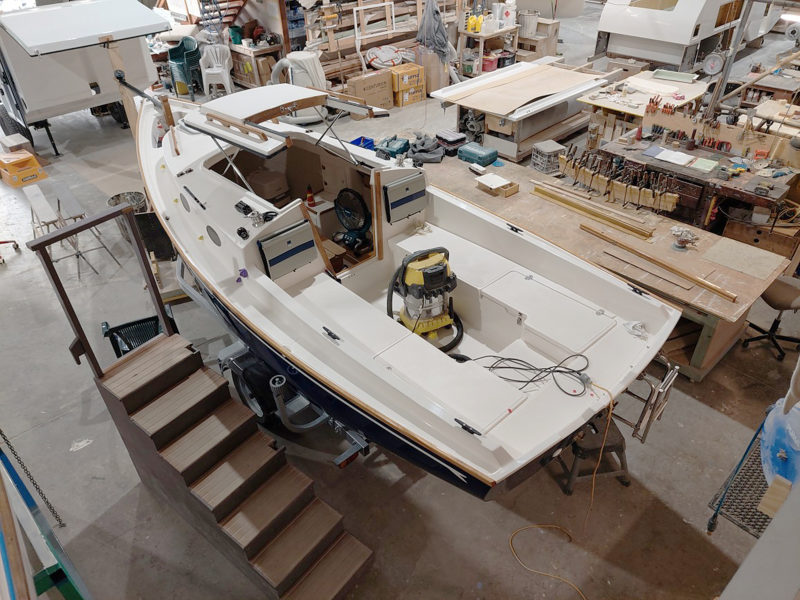
Still in the shop under construction, the lifting coach roof, with its simple expanding cross-struts, is clearly visible. This unusual feature increases headroom, ventilation, and natural light in the cabin.
The hull is built in two pieces. The first, a hand-laid, solid fiberglass molding, incorporates the hull and centerboard case. The second molding, also of hand-laid fiberglass, includes the deck, cabin, cockpit, water-ballast tanks, and interior structures including the berths. The two moldings are joined by an external hull flange at the gunwale, which is capped with a Pacific teak (Vitex) rubrail. Between the rubrail and the coach roof there is a narrow side deck, which provides a secure walkway along the entire length of the boat. The mast, gaff, boom, and bowsprit are carbon fiber and the sails are from Hood Sails in Sydney.
The mast is stepped in a deck-mounted stainless-steel tabernacle supported by a stainless-steel compression post mounted on the keel; it is held in place with a stainless-steel through-pin. The rudder is hung on bronze pintles and is easily removable. The foiled centerboard is of laminated fiberglass with 220 lbs of internal lead ballast. The bowsprit is mounted to the samson post, which acts as a secure mooring bitt.
All surfaces (hull, deck, coach roof, and interior) are offered in Oyster White as standard, but there is a wide range of hull-color options.
The rigging, and most of the deck hardware, is from Ronstan or Harken including jib tracks, jam cleats, mooring cleats, and standing-rigging fittings. The shrouds are U-bolted through the hull-and-deck joint, while the forestay is bolted to the end of the bowsprit, and the bobstay is U-bolted to the stem just above the boot top. Tufnell blocks and Langman cordage are fitted as standard and further complement the traditional look and feel of gaff-rigged boats.
Construction, including all rigging and interior outfitting, is by Bluewater Cruising Yachts who offer various optional items. For example, I chose to add four wooden Pacific teak (Vitex) handrails, a pop-top incorporated with the companionway hatch that includes a color-matched WeatherMAX UV fabric enclosure that features roll-up window covers, bug screens, and complete companionway zip-through access. It allows for full standing headroom below and increases the cabin’s natural light and ventilation.
While the Cygnet 20 is a production boat, that does not prevent the enthusiast from adding their own personal touches. I have added cabin instruments, including a barometer and clock, and a depthsounder, fitted a removable anchor roller, replaced the original sheet bags, and am working on wooden racks for a hand-held VHF, binoculars, and iPad.
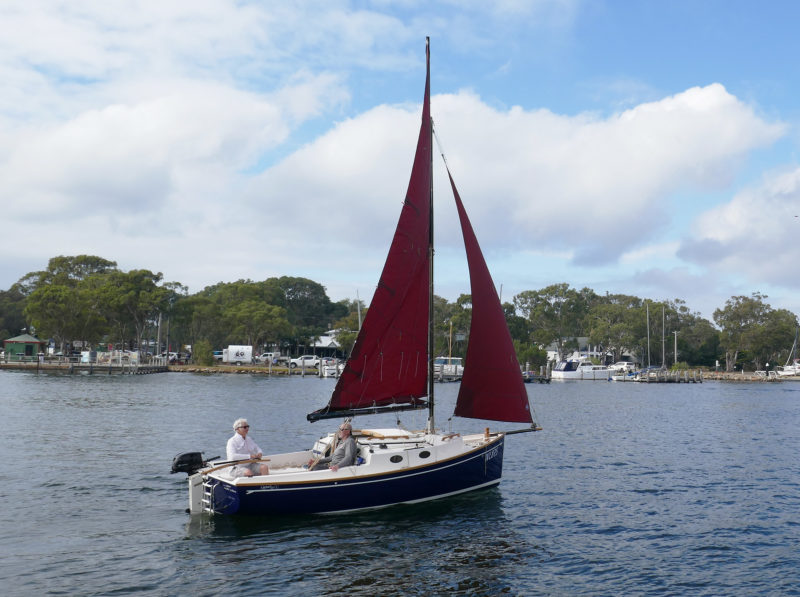
The spacious cockpit and high boom offer plenty of comfort for sailing with company, and with a tiller extension and running lines that all lead back to the cockpit, everything is easily to hand for the singlehanded sailor.
T he Cygnet 20 has a towing weight of 1,874 lbs. Loaded onto a single-axle trailer, offered by Bluewater, the Cygnet 20 can be towed by most family cars or an SUV.
When the Cygnet 20’s mast is lowered it pivots in the tabernacle, along with the boom, gaff, and both sails, which remain attached, and it is supported on a removable timber boom crutch at the stern. The rig is raised and lowered complete—the sails are bent on, the gaff and boom are attached to the mast, and the furled jib is left in place on the forestay. To rig the boat is straightforward, even for a singlehander: insert the two drain bungs, remove the trailer straps, remove and roll-up the one-piece sail cover, attach the Windex vane to the masthead, loosen all lines and remove any ties, and raise the mast while hauling in the forestay, which is led through a sheave at the end of the bowsprit then back to the cockpit. After the mast comes to a stop—fully upright in the tabernacle—the person doing the hauling walks forward to tie the forestay off at a bow-mounted cleat. Finally, a stainless-steel locking pin is inserted through the tabernacle and mast.
All that remains to be done is to raise the topping lift to free the boom crutch so it can be folded and put away, adjust the shroud tension (if necessary), tidy all lines, hang fenders, give one final check all around, and then launch the boat off the trailer. From start to finish, the boat can be rigged and launched within 30 minutes.
Thanks to the hull profile, the Cygnet 20 can stand upright when dried out. The forefoot is deep and flows into a wide, flat keel plank. With the engine, rudder, and centerboard raised you can run the boat up onto a sandy beach, drop the sand anchor, and camp overnight.
T he cockpit features two lazarettes, a deep coaming for good back support and a dry ride in a strong wind, and a nonskid surface throughout that offers surprisingly comfortable seating even without cushions. There is no mainsheet traveler; instead, the mainsheet is led through a 4:1 block-and-tackle system anchored in the center of the cockpit sole. As a result, the cockpit feels uncluttered and spacious and has ample seating for four adults. The starboard lazarette houses the fuel tank for the outboard motor as well as access for the fuel line. The port lazarette houses a hand-operated bilge pump, which is also used to empty the two internal water-ballast tanks, one located beneath (and across) the two quarter berths and the other tank beneath (and across) the cockpit sole aft of the centerboard. Each has a capacity of 63-1⁄2 U.S. gallons, and water is let in via a bronze through-hull and stainless-steel valves. The rear tank, subject to sailing conditions and preferences, can be isolated and not filled; filling the forward tank is a prerequisite before setting off. I found that on light wind days, with four adults on board, the Cygnet was well-balanced with only the forward ballast tank filled to capacity.
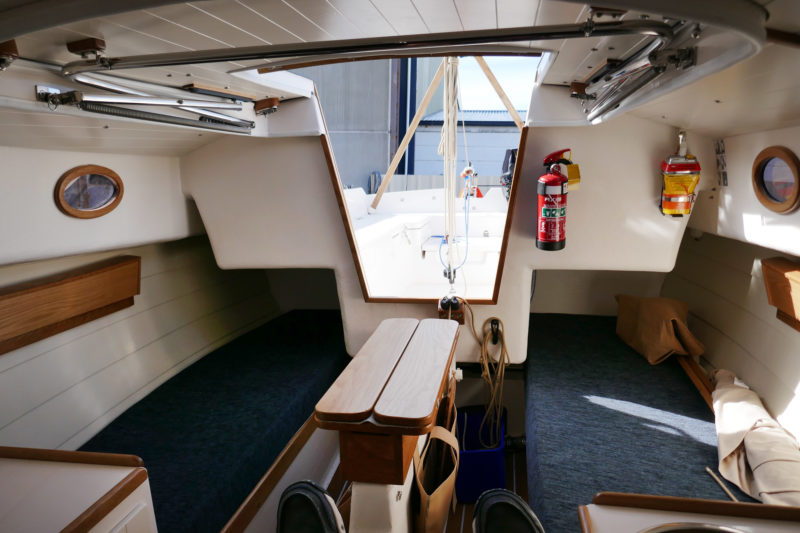
The two quarter berths are each more than 6′ in length making them suitable for taller crewmembers. The optional folding table sits above the centerboard trunk and provides a useful work surface even when folded away; when extended it is large enough for four people to dine in comfort.
Emptying the tanks requires about 100 strokes for the forward tank or about 150 strokes for both tanks. The system offers ballast flexibility: it can be adjusted according to conditions and crew numbers as well as used to reduce the weight for trailering. When filled, the ballast tanks add about 500 lbs to the overall weight.
D own below, the cabin has four berths. The two settee berths are 6′6″ long and ideal for those who are taller than 6′, while the V-berth in the bow is extremely comfortable for those under 6′. A porta-potti stows beneath the V-berth, while in the main cabin area there is a cupboard and sink to port and a cupboard with benchtop to starboard. An (optional) fold-out timber table, fitted over the centerboard case, provides adequate dining space for four. Lockers beneath all the berths—four under the settees and two under the V-berth—provide plenty of easily-accessed storage. The cabin sides and overhead are finished in V-grooved plywood, but other options are available. The companionway washboards are 7⁄16″ opaque acrylic and can be stowed in two purpose-made bags when not in use.
On my boat, auxiliary power is delivered by a Tohatsu 6-hp four-stroke long-shaft outboard mounted directly to the port side of the transom. (Previously a center motorwell for an inboard-outboard motor was offered, but this has been converted to a locker that can be used as an ice box—just add a bag of ice and your favorite drinks.) My motor can power the boat, with bare poles, up to 5 knots with minimal effort. A connecting arm from the outboard to a tiller provides positive control, in forward and reverse, and can be disengaged when sailing; it is part of Cygnet outfitting. The outboard can be raised out of the water when sailing to reduce drag. The tiller is Pacific teak (Vitex), and the fiberglass rudder blade can be pivoted up above the waterline for beaching and trailering.
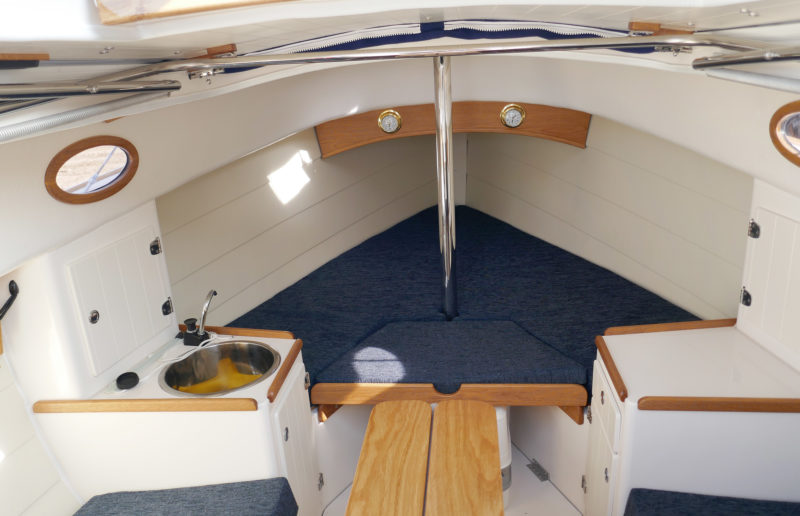
There is plenty of natural light throughout the cabin, thanks to the portlights, large companionway hatch and, when opened, the lifting coachroof. The forward V-berth conceals a porta-potti and lockers beneath its cushions.
U nder sail, movement around the cockpit is easy and the view forward is rarely obscured by the jib. The running lines, including jibsheets, all three halyards—jib, peak, and throat—and the topping lift are led back to jam cleats on the cabintop, within easy reach of the crew. I have added a Ronstan tiller extension so that I can also reach all the lines when helming, taking just one step forward to trim either sail while maintaining complete control of the rudder.
The Cygnet 20 provides a remarkably stable platform that tracks true and holds its course with a very light touch on the tiller. The pivoting centerboard, raised and lowered on a 10:1-ratio winch, allows the crew to bring the center of gravity aft in stronger winds by raising the board 25%, which in turn improves the windward heading. In approximately 10 knots of breeze, Navionics on the iPhone recorded our speed between 5.4 and 6.0 knots. The boat is exceptionally responsive to the helm and easily picks up speed after tacking. There’s no concern when jibing, as the helmsman can easily swing the main across with the mainsheet directly at hand.
The water ballast allows the boat’s center of gravity to be lowered, making the boat both more stable and more comfortable in stronger winds; the relatively short and light rig also contributes to this stability.
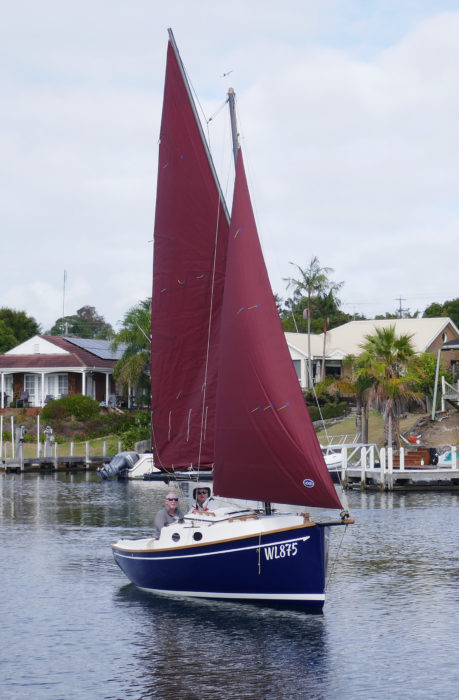
The plumb stem, short bowsprit, high-peaked gaff, tanbark sails, and traditional reefpoints clearly reflect the influence of late-19th and early-20th-century British working boats. Less obvious are the modern rigging details that allow one person to rig, launch, and set sail within 30 minutes.
The mainsail has two rows of reefpoints, and with the roller-furling jib there is a great deal of scope for shortening sail as the need arises. Additionally, the gaff-rigged mainsail can be scandalized: by lowering the peak, the sail is almost entirely depowered, and while this is not a good long-term solution for coping with heavy weather, it is a handy trick if you need to reduce sail area quickly and temporarily. A vang delivers control to the boom.
B eing designed for inland waterways, the Cygnet 20 does have (some) limitations (well, the only one that comes to mind is that I would not be keen to take it to sea, out of sight of land), but that does not preclude sailing in and around bays, coastal islands, and major rivers that open to the ocean. The versatility of the boat for inland sailing is hard to beat. The Cygnet can be fitted for rowing, complete with sliding seat on tracks set into the parallel cockpit benches, and carbon-fiber oars. When combined with the low height of the rig—just 19′ above the cabintop—and the ability to quickly lower the whole rig even when on the water, this rowing option allows the Cygnet 20 to explore many less accessible rivers and streams, even those crossed by fixed bridges.
I continue to enjoy the boat whatever the season, conditions, or locality, whether I’m cruising with my wife and friends, or just out for an enjoyable daysail on my own. At time of writing, I have booked the next sailing trip inter-state to Tasmania, taking full advantage of having a trailer-sailer that can be ferried overnight (approximately 245 nautical miles). Once in Tasmania, I will be faced with the difficult decision of choosing the first sailing destination from my wish list of about 50 lakes, rivers, bays, and coastal islands.
Jan Stephen Kent is the eldest of three children of Polish migrants who arrived in Australia in the early 1950s. Born and raised in Hobart, Tasmania, his love for the ocean came when he began surfing when he was 14 and has remained with him. He has surfed Peru, Portugal, South Africa, and most of Australia. He has five adult children and three grandchildren. He and his wife have traveled to Peru, Chile, Argentina, southern Africa countries, most of Europe and parts of Asia, and have sailed off Croatia and Sardinia. Set to retire late in 2023, he is still surfing, and messing around in boats has become his passion.
Cygnet Particulars
LOA/19′2-1⁄2″
LWL/17′8-1⁄2″
Beam/7′3-3⁄4″
Draft, centerboard up/ 1′1-1⁄2″
Draft, centerboard down/5′1-3⁄4″
Displacement (loaded)/2,756 lbs
Towing weight (not including trailer)/ 1,764 lbs
Jib/77 sq.ft
Mainsail/176.5 sq.ft
Fuel tank/3 gallons (US)
Fresh-water tank/5 gallons (US)
Required engine size/4hp
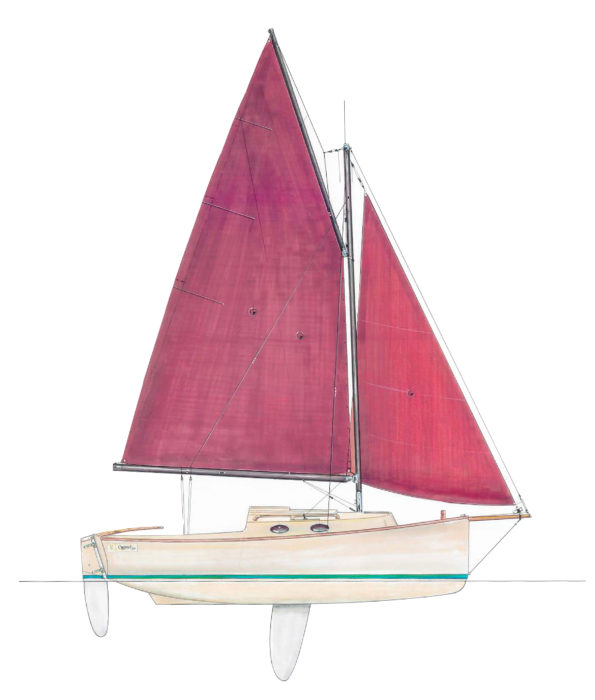
The Cygnet 20 is manufactured by Bluewater Cruising Yachts in Cardiff, New South Wales, Australia. The listed price is $72,600 AUS plus GST.
Is there a boat you’d like to know more about? Have you built one that you think Small Boats readers would enjoy? Please email us!
Share this article
Join The Conversation
We welcome your comments about this article. If you’d like to include a photo or a video with your comment, please email the file or link.
One thought on “ Cygnet 20 ”
I really like this design and the size is my favorite, easy to trailer and launch, and keep at home and visit many different places. I’m not a fan of the sliding Gunter mainsail rigging, and would consider changing that with recommendations from the designer.
Leave a Reply Cancel reply
Your email address will not be published. Required fields are marked *
Stay On Course
More From This Issue
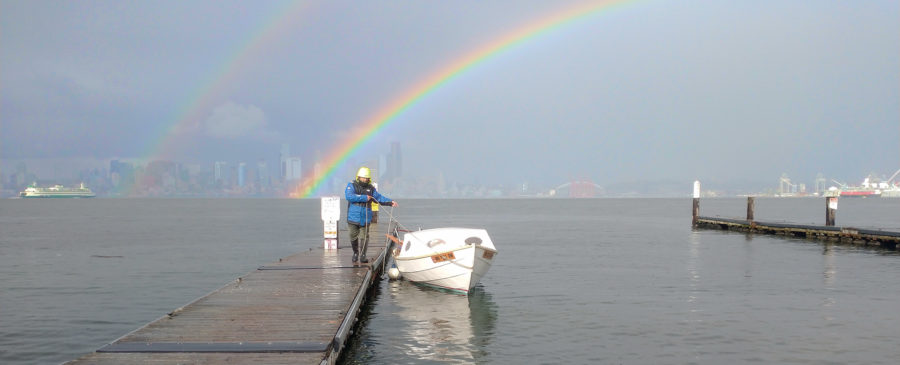
From The Editor
his past Father’s Day, my son Nate suggested we sail across Puget Sound to the village of Indianola for our annual outing. We had sailed there on a summer day...

The design was inspired by England’s small traditional gaff-rigged working boats. It evokes the past with its plumb stem and only slightly raked transom, fixed bowsprit, samson post, transom-hung rudder…
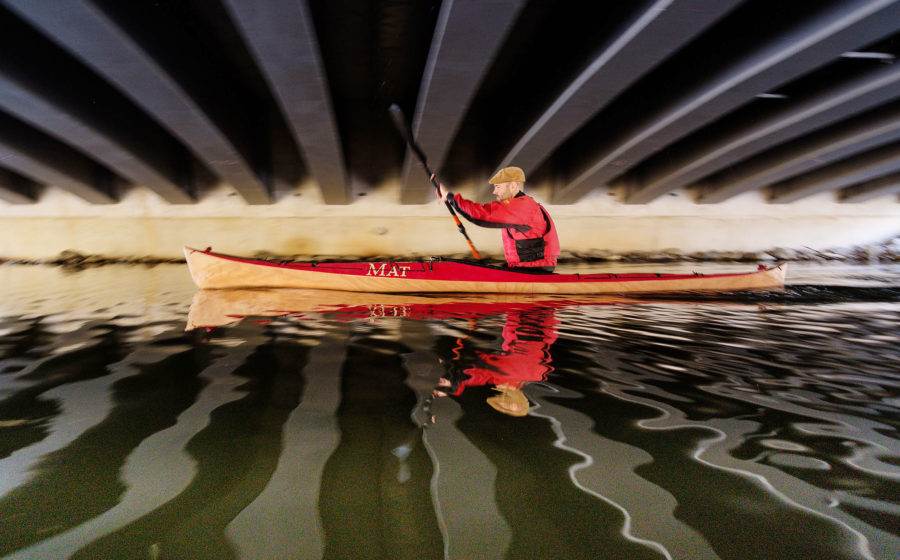
Petrel Play SG
I grew up as a whitewater paddler, and some years ago paddled a whitewater kayak to a little island in the Baltic Sea. The boat was quite capable in rough…
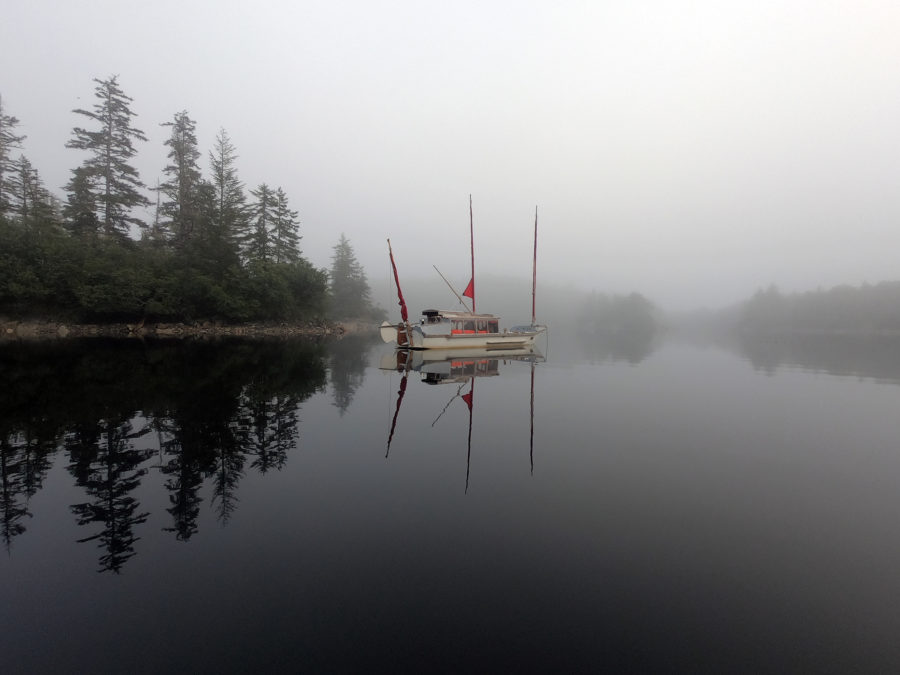
We had designed and built MUSTELID as a more easily driven adjunct to our larger, engineless liveaboard sailboat. As we have aged, sailing it has become more strenuous and we…
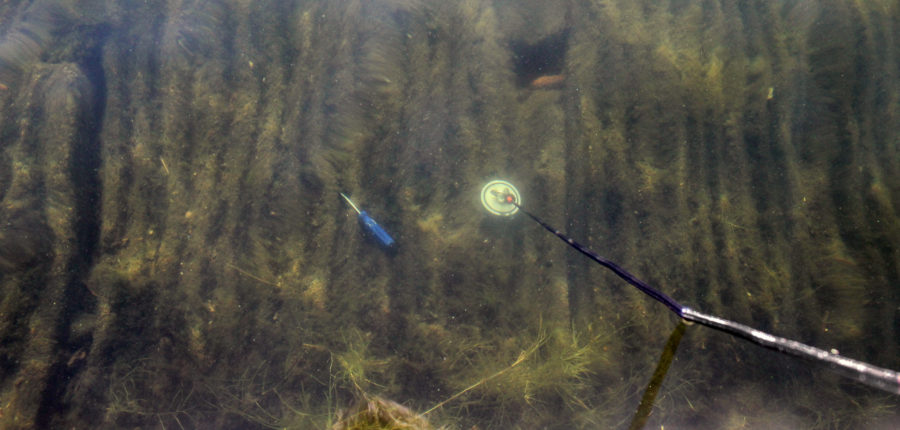
Magnet Retrieval
I was intrigued, for a while, by magnet fishing, but after seeing a lot of YouTube videos about it and watching a few magnet anglers at launch sites, I decided…
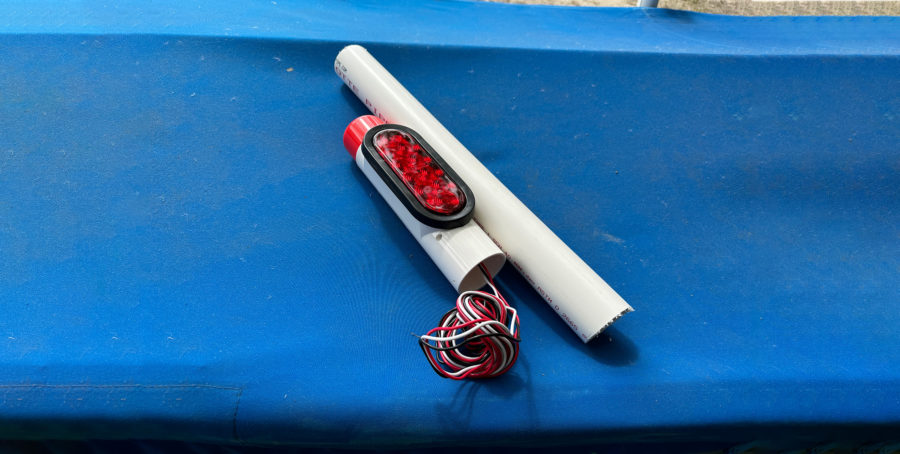
Product Reviews
Seavolt LED Tail Lights
We searched for trailer guidepost light kits and found an economical option, the SEAVOLT LED Trailer Guide-On kit. The kit consists of two LED light assemblies made from thick-walled PVC…
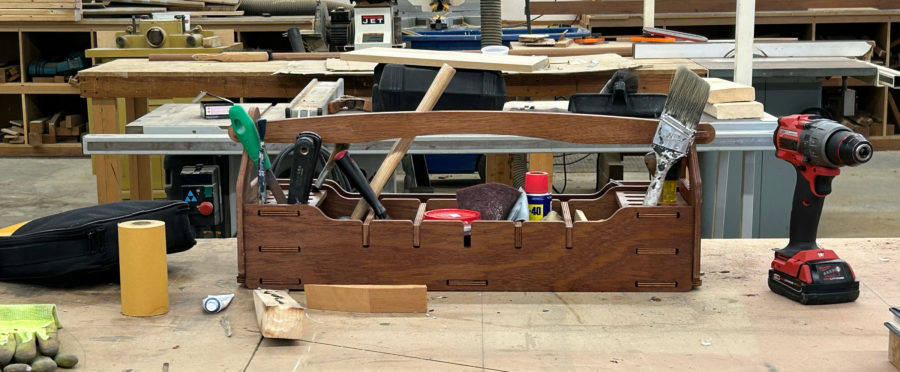
The CLC Tool Box Kit
After the shellac dried, all that was left to do was load up some tools. In each end, a shelf with holes can hold five screwdrivers and the two layers…
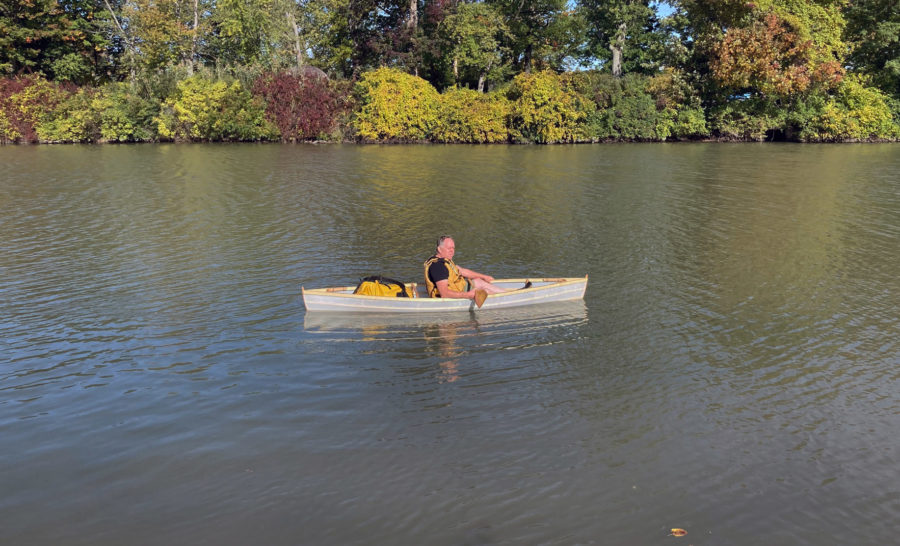
Reader Built Boats
Sharing a Sense of Freedom
John built his first boat, Percy Blandford’s PBK 26, a skin-on-frame kayak, when he was 16. He built two more for friends. Much later, in 1999, on leaving a career…
More Boat Profile
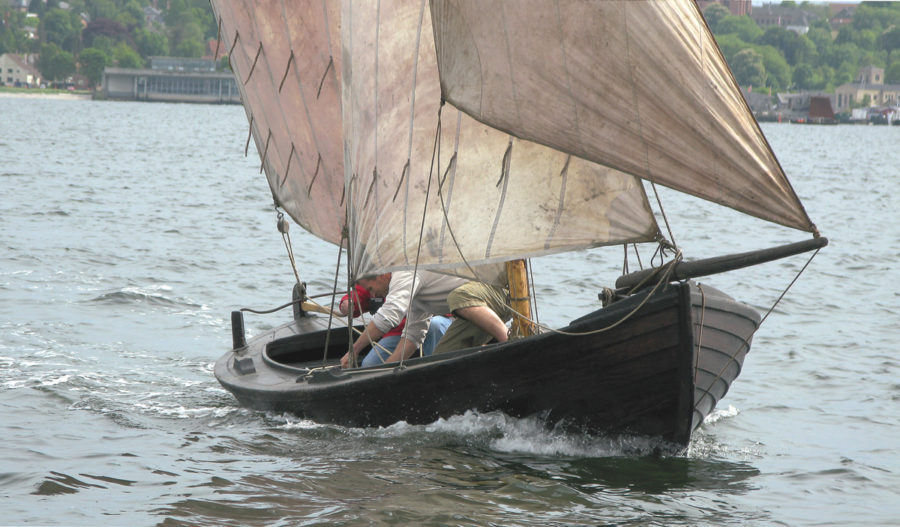
MARCUS NOER
MARCUS NOER is a particularly fine example of a traditional double-ender from Denmark, with a shapeliness to her hull that will take your breath away. The design is one descendant—one…
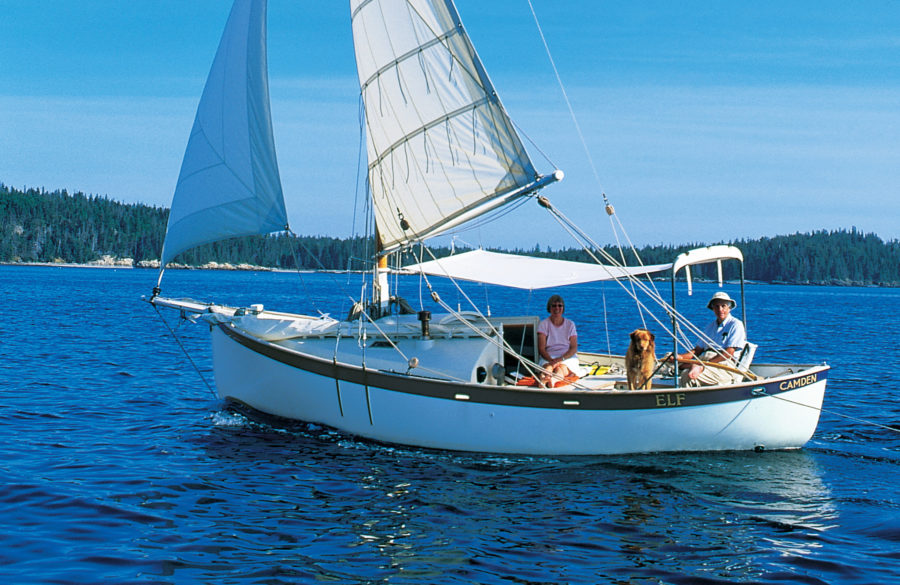
Paul Gartside's plans for modest-sized cruising boats inspired by the Falmouth cutters of his native England should all come with one of those warnings from the Surgeon General, this one…
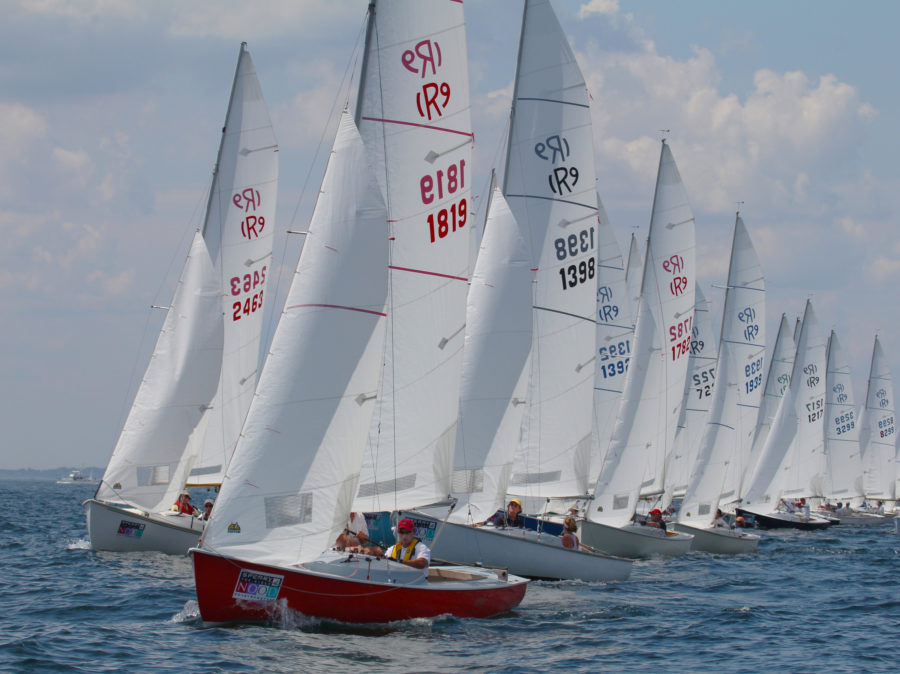
The Rhodes 19
Facing rising materials costs and a poor economy, O’Day had discontinued production of the Rhodes 19 by 1980. That could have been the end of the class, but its officers…
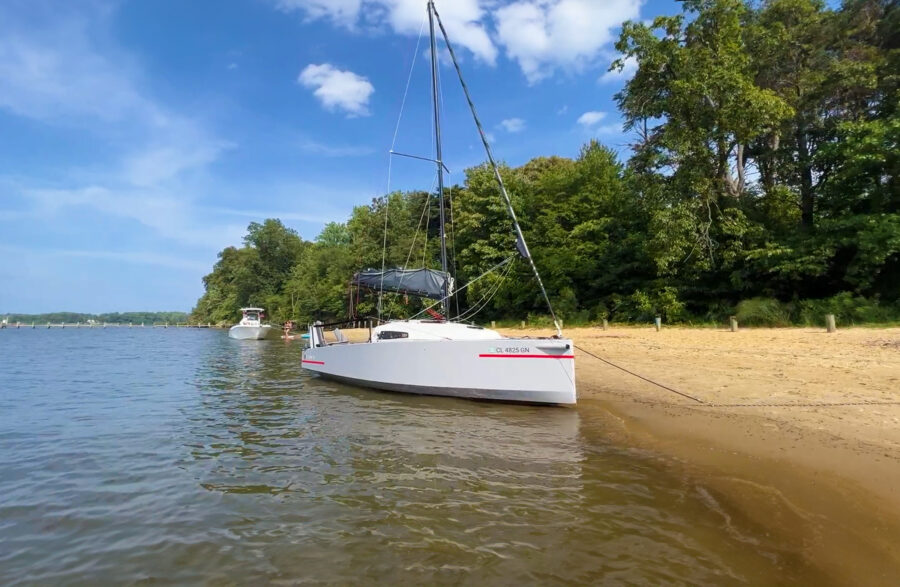
The Flow 19 is a trailerable sport cruiser designed for performance sailing with ample storage and cabin room for comfortable cruising.The lines are pure and racy, and the first few…
Subscribe Today!
Become a subscriber today and you’ll recieve a new issue every month plus unlimited access to our full archive of backlogged issues.
Already a subscriber? Sign In
Subscribe For Full Access
Flipbooks are available to paid subscribers only. Subscribe now or log in for access.
Alternatively,
- Register with Facebook
- Register with Google
Why Boatshed?
View all of your boats statistics in real time
Create a virtual "watch" on boats you're interested in
Refer a boat and earn up to 20% of the brokers commission
Language & Currency
Search our catalog, go direct, enter a boat reference, £ 0 sold / unavailable.
- Boat REF# · 133476
- Length · 20'0"
- Year · 1990
- Construction · GRP
- Underwater profile · Full-Displacement
- Engine · 1 x diesel 21hp, Yanmar 3GM (2010)
- Lying · Falmouth

Boatshed Cornwall
This boat is off the market but here are some boats that are still for sale.
- Specification
- Additional Information
Extra Details
| Builder | Cygnus Boats | Lying | Falmouth | Fuel capacity | 22.0 USG Total - 1 Tanks |
|---|
| Engine | 1 x diesel 21hp | Engine make and model | Yanmar 3GM (2010) | Engine Hours | engine1= low | Engine Cooled | Indirect | Steering | wheel | Drive | shaft | Prop(s) | 3 blade | Fuel consumption (approx) | 0.5 USG /hour At Cruising Speed | Cruising speed (approx) | 5 knots | Max speed (approx) | 7 knots |
|---|
| Length | 20'0" | Beam | 7'6" | Draft Min | 1'6" | Displacement | 5,512.5lbs | Storage | In water |
|---|
rigged Wood spars ()
| Other sails | mizzen () |
|---|
Construction
| Construction | GRP | Underwater profile | Full-Displacement | Finish | Paint finish |
|---|
Accommodation
| Cabin(s) | 1 |
|---|
| Rode | Fenders | Boathook |
|---|
1 anchors (folding) 40'0" of rode
Nav Equipment
| Compass | VHF | GPS | Chart plotter | Depth sounder |
|---|
Safety Equipment
| Life jackets | Life buoys | Danbuoy | Horn |
|---|
2 bilge pumps (1 manual / 1 electric)
Broker's Comments
These Cygnus boats are over engineered vessels, properly made for small scale commercial fishing and so most have had a pretty hard life, which is what they were designed for.
This particular one has had a somewhat easier time of it, as she has been used as a tourist mackerel fishing boat down here in Cornwall.
The boat is being sold as the owner needs a larger boat not due to the size of the fish but the numbers of tourists and as the boat has been used in this fashion, she has been subject to yearly inspections for council coding and consequently has been maintained to a very high level.
New engine went in last year at great expense and she has been surveyed this year with no issues so this represents great value.
These boat details are subject to contract. Note: Offers on the asking price may be considered.
Get Access to More
View unlimited photos of every boat
Walkthrough videos
VR 720° experiences
Get notified of new boats of your interest
Personalised boat recommendations
Save boats to 'My Boatshed'
Cost Of Ownership

- Forums New posts Unanswered threads Register Top Posts Email
- What's new New posts New Posts (legacy) Latest activity New media
- Media New media New comments
- Boat Info Downloads Weekly Quiz Topic FAQ 10000boatnames.com
- Classifieds Sell Your Boat Used Gear for Sale
- Parts General Marine Parts Hunter Beneteau Catalina MacGregor Oday
- Help Terms of Use Monday Mail Subscribe Monday Mail Unsubscribe
Need help for my Cygnus 20
- Thread starter eddy62
- Start date Apr 19, 2013
- Forums for All Owners
- Trailer Sailors
Just purchased a Cygnus 20. I have tried everywhere online and found very little on it except for a few pictures. I'm in need of the class rules and a rigging or owners manual. and info to make a new rudder.I have tried to contact owners in past posts who have this material ,with no success. Ed
Merlin Clark
I found some old traffic on the Sailrite forums: http://forum.sailrite.com/topic182.html with the last post in that thread in 2012. You might post there also in case one of those is still hanging around.
http://sailboatdata.com/viewrecord.asp?class_id=32 http://www.pbase.com/nonsuch/hinterhoeller_cygnus_20 Hope this helps.
As I have stated already. I have searched the internet these sites haven't been much help.There were promises in the past of owners going to post what they had in info ,but no one ever followed thru with it.Its difficult because I live in an area where these boats dont exist. I can't go to look at and see how things go together.
Eddie, Modern sloop sailboats are pretty much all the same in the way they are built and assembled. Might post to ask all sailors for help rigging the boat. Good luck.
Rigging is not the problem. Its more of what gthe original rudder looks like and measurments.I could use a rudder similar to a Rhodes 19 ,as its almost the same displacement. I tend to be very big on restoring things to the way they were , so this project is important to me.Also need to know how the original boot stripe layed out . Thanks Ed
Crazy Dave Condon
Eddy62; As a retired dealer, sometimes I was faced with repairs where I did not have the specific details and one of those was a rudder. I made one that worked fairly well with what knowledge I possessed and if you cannot find specs to the old rudder, may I suggest that you build one as close as possible and then go enjoy sailing my friend. If you are going to worry about being precise, that can be good but can also be bad and to worry over not having the specific details, I would say do your best and enjoy. DAVE CONDON
- This site uses cookies to help personalise content, tailor your experience and to keep you logged in if you register. By continuing to use this site, you are consenting to our use of cookies. Accept Learn more…
| | | | / |
- Show original
- Random article
From Wikipedia, the free encyclopedia
| Development | |
|---|---|
| Designer | |
| Location | |
| Year | 1963 |
| Builder(s) | Skene Boats |
| Boat | |
| weight | 950 lb (431 kg) |
| 2.75 ft (0.84 m) | |
| Hull | |
| Type | |
| Construction | |
| 20.00 ft (6.10 m) | |
| 17.50 ft (5.33 m) | |
| 7.00 ft (2.13 m) | |
| Engine type | |
| Hull appendages | |
| Keel/board type | |
| Ballast | 140 lb (64 kg) cast iron |
| Rudder(s) | transom-mounted |
| Rig | |
| Rig type | |
| I (foretriangle height) | 18.75 ft (5.72 m) |
| J (foretriangle base) | 6.33 ft (1.93 m) |
| P (mainsail luff) | 23.00 ft (7.01 m) |
| E (mainsail foot) | 10.33 ft (3.15 m) |
| Sails | |
| Sailplan | |
| area | 118.80 sq ft (11.037 m ) |
| / area | 59.34 sq ft (5.513 m ) |
| Total sail area | 178.14 sq ft (16.550 m ) |
The Cygnus 20 is a Canadian trailerable sailboat that was designed by George Hinterhoeller and first built in 1963. [1] [2]
- 1 Production
- 2 Design
- 3 Variants
- 4 See also
- 5 References
- 6 External links
The design was initially built in 1963 by Hinterhoeller Yachts in Niagara Falls, Ontario , Canada and Clarkecraft of St Catharines, Ontario . When that company was absorbed into C&C Yachts in 1969 and the Cygnus 20 tooling was sold to Skene Boats of Gloucester, Ontario . That company went out of business in 1992 and the design went out of production. [1] [3] [4] [5] [6]
The centreboard boat was originally sold as the HR 20, but after a class association was formed in 1965-66 the design was renamed the Cygnus 20. It was produced in both centreboard and fixed keel versions from 1965. [1] [7] [8]
The Cygnus 20 is a recreational centreboard boat, or optionally a keelboat , built predominantly of fibreglass , with teak wooden trim above decks and mahogany below decks. It has a fractional sloop rig with aluminum spars, a spooned raked stem , a vertical transom , a transom-hung wooden rudder controlled by a tiller and a centreboard or fixed fin keel . It has a fibreglass buoyancy tank and can be fitted with a detachable cuddy cabin top. For stowage it has an aft lazarette . [1] [4] [5]
The boat is normally fitted with a small 3.5 to 6 hp (3 to 4 kW) outboard motor for docking and manoeuvring. [1] [4]
- List of sailing boat types
- ^ McArthur, Bruce (2020). "George Hinterhoeller" . sailboatdata.com . Archived from the original on 16 June 2020 . Retrieved 27 August 2020 .
- ^ McArthur, Bruce (2020). "Hinterhoeller Yachts Ltd" . sailboatdata.com . Archived from the original on 16 June 2020 . Retrieved 27 August 2020 .
- ^ a b c Clarkecraft. "The Cygnus 20 Daysailer Camper" . pbase.com . Archived from the original on 27 August 2020 . Retrieved 27 August 2020 .
- ^ a b Clarkecraft. "The Incomparable Cyngus 20 by Clarkecraft" . pbase.com . Archived from the original on 27 August 2020 . Retrieved 27 August 2020 .
- ^ McArthur, Bruce (2020). "Skene Boats Ltd. 1968 - 1992" . sailboatdata.com . Archived from the original on 29 June 2020 . Retrieved 27 August 2020 .
- ^ a b McArthur, Bruce (2020). "HR 20 (Cygnus) sailboat" . sailboatdata.com . Archived from the original on 27 August 2020 . Retrieved 27 August 2020 .
- ^ a b McArthur, Bruce (2020). "Cygnus 20 FK sailboat" . sailboatdata.com . Archived from the original on 27 August 2020 . Retrieved 27 August 2020 .
External links
| Niagara | |
|---|---|
| Other sailboats | |
| People | |
| and trailer yachts | |
|---|---|

Hr 20 cygnus
The hr 20 cygnus is a 20.0ft fractional sloop designed by george hinterhoeller and built in fiberglass since 1963..
The Hr 20 cygnus is an ultralight sailboat which is a very high performer. It is stable / stiff and has a low righting capability if capsized. It is best suited as a racing boat.
Hr 20 cygnus for sale elsewhere on the web:

Main features
| Model | Hr 20 cygnus | ||
| Length | 20 ft | ||
| Beam | 7 ft | ||
| Draft | 0.67 ft | ||
| Country | ?? | ||
| Estimated price | $ 0 | ?? |
Login or register to personnalize this screen.
You will be able to pin external links of your choice.

See how Sailboatlab works in video
| Sail area / displ. | 40.13 | ||
| Ballast / displ. | 0 % | ||
| Displ. / length | 49.98 | ||
| Comfort ratio | 3.80 | ||
| Capsize | 3.32 |
| Hull type | Monohull centerboard | ||
| Construction | Fiberglass | ||
| Waterline length | 17.50 ft | ||
| Maximum draft | 2.67 ft | ||
| Displacement | 600 lbs | ||
| Ballast | 0 lbs | ||
| Hull speed | 5.61 knots |

We help you build your own hydraulic steering system - Lecomble & Schmitt
| Rigging | Fractional Sloop | ||
| Sail area (100%) | 0 sq.ft | ?? | |
| Air draft | 0 ft | ?? | |
| Sail area fore | 59.34 sq.ft | ||
| Sail area main | 118.80 sq.ft | ||
| I | 18.75 ft | ||
| J | 6.33 ft | ||
| P | 23 ft | ||
| E | 10.33 ft |
| Nb engines | 1 | ||
| Total power | 0 HP | ||
| Fuel capacity | 0 gals |
Accommodations
| Water capacity | 0 gals | ||
| Headroom | 0 ft | ||
| Nb of cabins | 0 | ||
| Nb of berths | 0 | ||
| Nb heads | 0 |
Builder data
| Builder | ?? | ||
| Designer | George Hinterhoeller | ||
| First built | 1963 | ||
| Last built | 0 | ?? | |
| Number built | 0 | ?? |
Modal Title
The content of your modal.
Personalize your sailboat data sheet
Cygnus 20 (Q98690544)
| Language | Label | Description | Also known as |
|---|---|---|---|
| English |

Identifiers
Wikipedia (1 entry).
- enwiki Cygnus 20
Wikibooks (0 entries)
Wikinews (0 entries), wikiquote (0 entries), wikisource (0 entries), wikiversity (0 entries), wikivoyage (0 entries), wiktionary (0 entries), multilingual sites (1 entry).
- commonswiki Category:Cygnus 20
Navigation menu
Great choice! Your favorites are temporarily saved for this session. Sign in to save them permanently, access them on any device, and receive relevant alerts.
- Sailboat Guide
Cygnus 20 FK
Cygnus 20 FK is a 20 ′ 0 ″ / 6.1 m monohull sailboat designed by George Hinterhoeller and built by Hinterholler Ltd. /Skene Boats Ltd. (CAN) starting in 1965.
Rig and Sails
Auxilary power, accomodations, calculations.
The theoretical maximum speed that a displacement hull can move efficiently through the water is determined by it's waterline length and displacement. It may be unable to reach this speed if the boat is underpowered or heavily loaded, though it may exceed this speed given enough power. Read more.
Classic hull speed formula:
Hull Speed = 1.34 x √LWL
Max Speed/Length ratio = 8.26 ÷ Displacement/Length ratio .311 Hull Speed = Max Speed/Length ratio x √LWL
Sail Area / Displacement Ratio
A measure of the power of the sails relative to the weight of the boat. The higher the number, the higher the performance, but the harder the boat will be to handle. This ratio is a "non-dimensional" value that facilitates comparisons between boats of different types and sizes. Read more.
SA/D = SA ÷ (D ÷ 64) 2/3
- SA : Sail area in square feet, derived by adding the mainsail area to 100% of the foretriangle area (the lateral area above the deck between the mast and the forestay).
- D : Displacement in pounds.
Ballast / Displacement Ratio
A measure of the stability of a boat's hull that suggests how well a monohull will stand up to its sails. The ballast displacement ratio indicates how much of the weight of a boat is placed for maximum stability against capsizing and is an indicator of stiffness and resistance to capsize.
Ballast / Displacement * 100
Displacement / Length Ratio
A measure of the weight of the boat relative to it's length at the waterline. The higher a boat’s D/L ratio, the more easily it will carry a load and the more comfortable its motion will be. The lower a boat's ratio is, the less power it takes to drive the boat to its nominal hull speed or beyond. Read more.
D/L = (D ÷ 2240) ÷ (0.01 x LWL)³
- D: Displacement of the boat in pounds.
- LWL: Waterline length in feet
Comfort Ratio
This ratio assess how quickly and abruptly a boat’s hull reacts to waves in a significant seaway, these being the elements of a boat’s motion most likely to cause seasickness. Read more.
Comfort ratio = D ÷ (.65 x (.7 LWL + .3 LOA) x Beam 1.33 )
- D: Displacement of the boat in pounds
- LOA: Length overall in feet
- Beam: Width of boat at the widest point in feet
Capsize Screening Formula
This formula attempts to indicate whether a given boat might be too wide and light to readily right itself after being overturned in extreme conditions. Read more.
CSV = Beam ÷ ³√(D / 64)
This from CYGNUS owner ‘barklakemike’: “George Hinterhoeller in Niagara actually designed and built the first the HR 20 as he called it, in 1963…. A class association formed in 1965 or 66 and the boat was renamed the Cygnus class. The tooling was sold to Skene in Ottawa, (who also made Albacores); when Hinterhoeller became one of three boatbuilders (including Morch in Belleville and Bruckmann in Oakville) who combined forces to make up the manufacturing side of the new C and C yachts. …the Cygnus was available with either a fixed cast iron keel and 2 ft 9 in draft, or with a fully retracting steel centerboard, when it weighed only 600 lbs.”
Embed this page on your own website by copying and pasting this code.
Discover Related Sailboats
- About Sailboat Guide
©2024 Sea Time Tech, LLC
This site is protected by reCAPTCHA and the Google Privacy Policy and Terms of Service apply.



COMMENTS
Coach roof/cuddy is detachable. This from CYGNUS owner 'barklakemike': "George Hinterhoeller in Niagara actually designed and built the first the HR 20 as he called it, in 1963. A class association formed in 1965 or 66 and the boat was renamed the Cygnus class. [Another early builder of the CYGNUS was Clarkecraft of St Catharines, Ontario].
The Cygnus 20 is a recreational centreboard boat, or optionally a keelboat, built predominantly of fibreglass, with teak wooden trim above decks and mahogany below decks. It has a fractional sloop rig with aluminum spars, a spooned raked stem, a vertical transom, a transom-hung wooden rudder controlled by a tiller and a centreboard or fixed fin keel.It has a fibreglass buoyancy tank.
Cygnus 20 is a 20′ 0″ / 6.1 m monohull sailboat designed by George Hinterhoeller and built by Hinterhoeller Yachts Ltd. and Skene Boats Ltd. starting in 1965. ... The lower a boat's ratio is, the less power it takes to drive the boat to its nominal hull speed or beyond. Read more. Formula. D/L = (D ÷ 2240) ÷ (0.01 x LWL)³ D: Displacement ...
1. Cygnus 20 Toronto. Feb 28, 2011. #9. Sails. If your looking for sails for a Cygnus , a Sharks mainsail will fit it almost perfectly. It is about 1" shorter on the foot. Lots of used Shark sails available. The Jib is about 9 " to long, but could be trimmed for about $150.
CYGNUS 20, designer George Hinterhoeller, builder Hinterholler Ltd. /Skene Boats Ltd., Centerboard (Trunk), Fiberglass, Fractional Sloop, 20 feet News Directory Boats Builders/Suppliers Models Common
The Cygnus 20 fk is a 20.0ft fractional sloop designed by George Hinterhoeller and built in fiberglass by Hinterhoeller Yachts Ltd. since 1965. The Cygnus 20 fk is an ultralight sailboat which is a very high performer. It is stable / stiff and has a low righting capability if capsized. It is best suited as a day-boat.
The immersion rate is defined as the weight required to sink the boat a certain level. The immersion rate for Cygnus 20 is about 76 kg/cm, alternatively 425 lbs/inch. Meaning: if you load 76 kg cargo on the boat then it will sink 1 cm. Alternatively, if you load 425 lbs cargo on the boat it will sink 1 inch.
The Cygnet 20 originated in 2013 with a brief by Bluewater Cruising Yachts' founder, David Bradburn, presented to yacht designers Will Hardcastle and Peter Lowe, to create an entry-level cruising yacht at an affordable price, with overnight or weekend accommodation for a couple or family of four. In August 2017, the prototype was launched at ...
I am looking for information on an old boat designed by Hinterholler. A Cygnus 20' Sloop. It is a smaller version of the Shark. Nothing appears on the web. Would like a copy of the promotional phamphlet if possible and any other information out there. I believe they were built in Ontario in...
Cignus 20 from the 80's. Boat is in good shape overall but needs repairs cosmetically and maybe structurally. The boat does have a trailer that needs new tires. ... Cygnus 20' sailboat. CA$800. Listed 3 weeks ago. 3 weeks ago. in Pointe-Claire, QC. Message. Message. Save. Save. Share. Details. Condition. Used - Fair. Cignus 20 from the 80 ...
Cygnus 20 for sale | 20'0" | 1990 | 1x diesel 21hp | GRP Construction | Full-Displacement underwater profile | Boat REF# 133476
Just purchased a Cygnus 20. I have tried everywhere online and found very little on it except for a few pictures. I'm in need of the class rules and a rigging or owners manual. and info to make a new rudder.I have tried to contact owners in past posts who have this material ,with no success. Ed
The Cygnus 20 is a 20.0ft fractional sloop designed by George Hinterhoeller and built in fiberglass by Hinterhoeller Yachts Ltd. since 1965. The Cygnus 20 is an ultralight sailboat which is a very high performer. It is stable / stiff and has a low righting capability if capsized. It is best suited as a racing boat.
Cygnus 20. Quite the same Wikipedia. Just better. What we do. Every page goes through several hundred of perfecting techniques; in live mode. Quite the same Wikipedia. Just better.
The George Hinterhoeller-designed Cygnus 20 was produced as both a centreboard boat and a keelboat. Boats. Summary of boats built by Skene Boats: Albacore; Cygnus 20; Echo 12; Phoenix 18; International 420; See also. List of sailboat designers and manufacturers; References ...
The Hr 20 cygnus is a 20.0ft fractional sloop designed by George Hinterhoeller and built in fiberglass since 1963. The Hr 20 cygnus is an ultralight sailboat which is a very high performer. It is stable / stiff and has a low righting capability if capsized. It is best suited as a racing boat.
The technical storage or access is strictly necessary for the legitimate purpose of enabling the use of a specific service explicitly requested by the subscriber or user, or for the sole purpose of carrying out the transmission of a communication over an electronic communications network.
Cygnus 20 (Q98690544) From Wikidata. Jump to navigation Jump to search. sailboat class. edit. Language Label Description Also known as; English: Cygnus 20. sailboat class. Statements. instance of. sailboat class. 0 references. subclass of. monohull. 1 reference. Wikimedia import URL.
Cygnus 20 FK is a 20′ 0″ / 6.1 m monohull sailboat designed by George Hinterhoeller and built by Hinterholler Ltd. /Skene Boats Ltd. (CAN) starting in 1965. ... A class association formed in 1965 or 66 and the boat was renamed the Cygnus class. The tooling was sold to Skene in Ottawa, (who also made Albacores); when Hinterhoeller became one ...
The Cygnet 20 is a perfect boat to begin a lifetime of sailing enjoyment. If getting out on the water has always been a dream put off until the endless "tomorrow" this is the boat to make that dream a reality. There's nothing like the fun of learning new skills and introducing the family to the fun of sailing.
This is a 1972, George Hinterhoeller, Cygnus. 20 ft long, 1,150 lb, centerboarder. It's a classic looking sailboat that's stiff, fast, and sails on rails. Google it to learn more. Contrary to information on google, it's actual weight is 1,150 lbs with everything needed to go in the water including the outboard. It's big enough to sleep on, small enough to put in and take out an
The Cygnet 20 from Bluewater Cruising Yachts is a modern classic gaff rigged trailer sailer.For more info see bwcy.com.au
Fit for cruising the Swan River, racing or raiding the vast and beautiful waterways around Australia, the Cygnet 20 works under sail, with a motor, and even with good old fashioned manpower. Sail, power or row the Cygnet 20 into your next grand adventure. Features Include: - Deck and hull made from handlaid GRP.